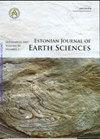Lower–Middle Ordovician brachiopods from the Eastern Cordillera of Peru: biostratigraphical and palaeobiogeographical significance
IF 0.8
4区 地球科学
Q4 GEOSCIENCES, MULTIDISCIPLINARY
引用次数: 0
Abstract
Lower–Middle Ordovician brachiopods are well known from the Central Andean Basin of Argentina and Bolivia, but relatively little data comes from its northern prolongation in the Altiplano and the Eastern Cordillera of Peru. Here we present information about brachiopods collected from the San José Formation (Fm) from several sections located at the northeast of the Apurímac River valley in the surroundings of Kimbiri city in the Eastern Cordillera. From northwest to southeast the sections and their locations are: Libertad, in the mountain trail between this hamlet and the city of Pichari; Catarata and Nueva Alianza, in the mountain trail between Oroya and the last hamlet; and Kimbiri ( K ) , in the trail parallel to the Kashiroveni stream north of the village of Kimbiri Alto. In these localities the San José Fm lies unconformably on Neoproterozoic rocks, reaching the maximum thickness of about 700 m. This shale-dominated formation comprises a biostratigraphically almost complete succession of the upper Tremadocian to lower Sandbian strata and contains graptolites, trilobites, brachiopods, molluscs, echinoderms and ostracods, as well as some conodonts and other microfossils. The upper part of the San José Fm is unconformably overlain by a thick sandy and diamictic succession, known as the Kimbiri Fm. About 30 fossiliferous levels have been found秘鲁东部科迪勒拉地区中下奥陶统腕足类:生物地层和古生物地理意义
中下奥陶统腕足动物在阿根廷和玻利维亚的安第斯盆地中部广为人知,但在其北部延伸的Altiplano和秘鲁的东科迪勒拉地区的资料相对较少。在这里,我们介绍了在东部科迪勒拉Kimbiri市周围Apurímac河谷东北部几个部分的San joss组(Fm)中收集的腕足类动物的信息。从西北到东南,这些路段和它们的位置是:Libertad,在这个村庄和Pichari市之间的山路上;卡塔塔和新阿里安萨,在奥罗亚和最后一个村庄之间的山路上;和Kimbiri (K),在Kimbiri Alto村以北与Kashiroveni河平行的小径上。在这些地区,圣何塞湖不整合地位于新元古代的岩石上,最大厚度约为700米。该组以页岩为主,生物地层上几乎完整地承继了上特拉马多纪至下沙边地层,包含笔石、三叶虫、腕足动物、软体动物、棘皮动物和介形虫,以及一些牙形刺和其他微化石。圣约瑟层的上部不整合地覆盖着一层被称为金比里层的厚砂和含砾层。已经发现了大约30个化石层
本文章由计算机程序翻译,如有差异,请以英文原文为准。
求助全文
约1分钟内获得全文
求助全文
来源期刊

Estonian Journal of Earth Sciences
地学-地球科学综合
CiteScore
1.50
自引率
9.10%
发文量
11
审稿时长
>12 weeks
期刊介绍:
The Estonian Journal of Earth Sciences is an international scientific open access journal published by the Estonian Academy of Sciences in collaboration with the Tallinn University of Technology, the University of Tartu, the Estonian University of Life Sciences and the Talllinn University.
The journal publishes primary research and review papers in the English language. All articles are provided with short Estonian summaries.
All papers to be published in the journal are peer reviewed internationally.
The journal is open for publications in all fields of Earth sciences, including besides different geological sensu lato disciplines, also geography and oceanography having certain connection with our part of the world, North Europe and the Baltic area in particular.
 求助内容:
求助内容: 应助结果提醒方式:
应助结果提醒方式:


